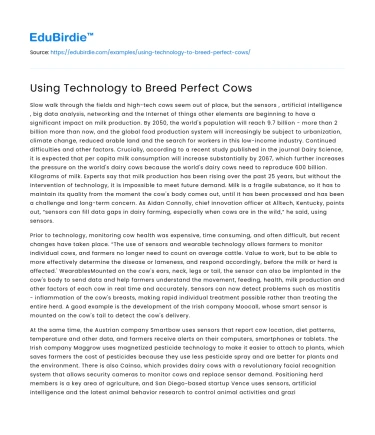Slow walk through the fields and high-tech cows seem out of place, but the sensors , artificial intelligence , big data analysis, networking and the Internet of things other elements are beginning to have a significant impact on milk production. By 2050, the world's population will reach 9.7 billion - more than 2 billion more than now, and the global food production system will increasingly be subject to urbanization, climate change, reduced arable land and the search for workers in this low-income industry. Continued difficulties and other factors. Crucially, according to a recent study published in the journal Dairy Science, it is expected that per capita milk consumption will increase substantially by 2067, which further increases the pressure on the world's dairy cows because the world's dairy cows need to reproduce 600 billion. Kilograms of milk. Experts say that milk production has been rising over the past 25 years, but without the intervention of technology, it is impossible to meet future demand. Milk is a fragile substance, so it has to maintain its quality from the moment the cow's body comes out, until it has been processed and has been a challenge and long-term concern. As Aidan Connolly, chief innovation officer at Alltech, Kentucky, points out, “sensors can fill data gaps in dairy farming, especially when cows are in the wild,” he said, using sensors.
Prior to technology, monitoring cow health was expensive, time consuming, and often difficult, but recent changes have taken place. “The use of sensors and wearable technology allows farmers to monitor individual cows, and farmers no longer need to count on average cattle. Value to work, but to be able to more effectively determine the disease or lameness, and respond accordingly, before the milk or herd is affected.' WearablesMounted on the cow's ears, neck, legs or tail, the sensor can also be implanted in the cow's body to send data and help farmers understand the movement, feeding, health, milk production and other factors of each cow in real time and accurately. Sensors can now detect problems such as mastitis - inflammation of the cow's breasts, making rapid individual treatment possible rather than treating the entire herd. A good example is the development of the Irish company Moocall, whose smart sensor is mounted on the cow's tail to detect the cow's delivery.
Save your time!
We can take care of your essay
- Proper editing and formatting
- Free revision, title page, and bibliography
- Flexible prices and money-back guarantee
At the same time, the Austrian company Smartbow uses sensors that report cow location, diet patterns, temperature and other data, and farmers receive alerts on their computers, smartphones or tablets. The Irish company Maggrow uses magnetized pesticide technology to make it easier to attach to plants, which saves farmers the cost of pesticides because they use less pesticide spray and are better for plants and the environment. There is also Cainso, which provides dairy cows with a revolutionary facial recognition system that allows security cameras to monitor cows and replace sensor demand. Positioning herd members is a key area of agriculture, and San Diego-based startup Vence uses sensors, artificial intelligence and the latest animal behavior research to control animal activities and grazing through virtual fences. Smart ear tags can make a sound, a slight vibration or a warning stimulus, allowing the cow to stay where the farmer wants, while also sending real-time data on the health of the cow. Considering the cost of land, especially the cost of pasture fence construction, this IoT supplier has now become the focus of attention of investors and large-scale agribusinesses. In today's IT-driven dairy farming, the monitoring and treatment of each animal has been greatly improved. Mark Keane, Principal Investigator of the Insight Center Data Analysis Center in Ireland, explained: “If you treat the entire herd, all of these cows will be resistant to antibiotics, but by using data and information from individual cows, we can identify Problem cows and treat them separately.' He said: 'Using precision farming methods, we analyze at every stage of the process. This begins with what the cows eat. Such foods, whether in the grass or in other fields, can properly promote their growth and yield.
This analysis continues to monitor all aspects of the cow and then continues into the milk production plant.' For example, the company now provides milk monitoring systems through sensors that measure the physical and chemical properties of milk, from protein to lactose levels to milk fat content, using optical, conductive, flow and thermal sensors with the milking machine. However, some dairy farms are taking further application techniques, starting with the cow's basic genome code. According to Mark Keane, the Irish Cattle Federation (ICBF) has compiled one of the world's most advanced databases for the development of quality dairy cows that increase milk production. Mark Keane insists: “It is the best way to adopt a coordinated approach to the national herd. In the United States, their size will become larger, but larger will not be better, because this breeding may have health problems, for example, Cows raised for milk production may have more fertility problems. Improving several characteristics will produce better results.” Illumina, a San Diego company that produces genetic research tools, began to unite with Irish cattle in 2015. The Society (ICBF) collaborates to help improve livestock reproduction by recording DNA variability and other data, and will continue these efforts by 2020 to encourage other countries to routinely genotype cattle. As technology advances, dairy farmers have made significant progress in increasing yield and animal health while reducing environmental impact. Aidan Connolly, chief innovation officer at Alltech, concluded: “The opportunity to use technology in agriculture is much greater than in any other industry because we traditionally use only a few data points to manage livestock, so IoT technology has brought Great growth opportunities.'






 Stuck on your essay?
Stuck on your essay?

